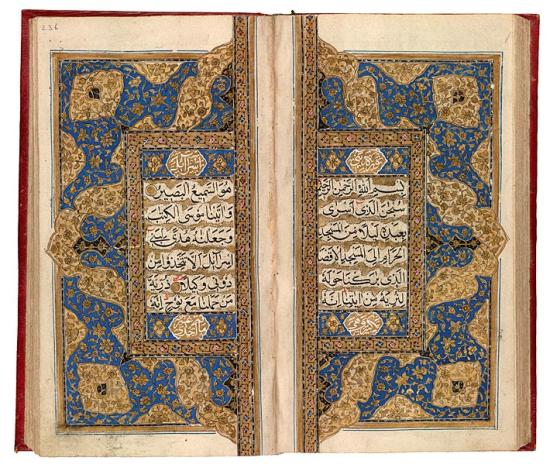
Qur˒an from Kashmir
Qur˒an, in Arabic
Gift of the Trustees of the William S. Glazier Collection, 1984
Qur˒ans were written by hand well into the nineteenth century, and many copies were produced about 1800, when Kashmir was still under Muslim rule. They differ from contemporary Turkish Qur˒ans, which usually provide a date and name of the scribe. The type of decoration found on this double-page sarlauḥ represents typical Kashmiri work of about 1800. This Qur˒an has been divided into sevenths (manzil), one to be read each day of the week, much like the Psalter. Here the double-page sarlauḥ marks the beginning of the fourth division, suras 17 (Bani Isrā-il or "The Israelites") to 25 (al-Furqān or "The Criterion"). The script is naskh, the sura headings are in white, and gold dots follow verses.
The Qur˒an, the Holy Book of Islam
From a monumental volume used in an Istanbul mosque to a miniature Persian version that served as a talisman, this section features examples of illuminated pages from the holy book of Islam. The Qur˒an (to recite) represents the codification of the words of God that were revealed and transmitted through the angel Gabriel to the prophet Muḥammad (ca. 570–632) over a period of twenty-three years. The visions began in 610 in a cave on Mount Hira near Mecca, his birthplace, and continued after his 622 flight to Medina, until his death. His flight—the Hijra—marks the beginning of the Islamic calendar.
The revelations were arranged into 114 suras (chapters), each named after its theme. The first and shortest ones, at the end of the book, from the Meccan period, establish Muḥammad as the final prophet in a line of monotheists, including Abraham and Jesus. The longest suras, placed at the beginning, are Medinan and deal more with social and political issues.
For centuries, Qur˒ans were written in Arabic, the language of transmission. After Muḥammad's death, his cousin ˓Alī and others compiled the revelations into a text. About twenty years later, under Uthman, the third caliph (644–656) succeeding Muḥammad, a standard version of the Qur˒an —essentially the one used today—was produced. Thereafter Islam (which means "surrender to God") spread from the Arabian Peninsula throughout the Middle East, to northern Africa and southern Spain, and eventually the world.
